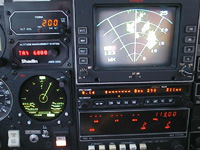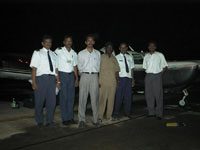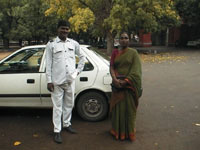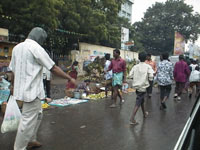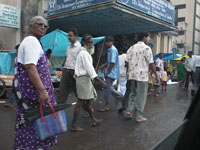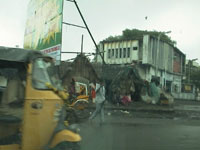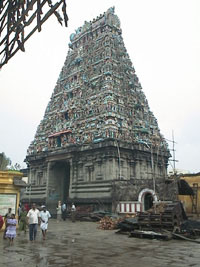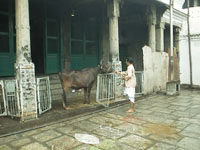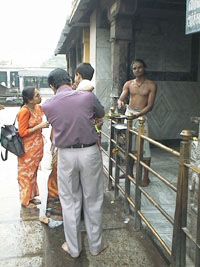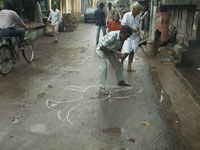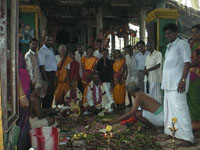![[image map, use itinerary]](/grphx/n_globe.gif) |
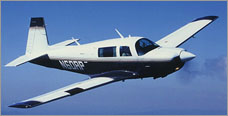 |
|
|
|
|
After a delightful day and night in Johor Bahru, I was picked up on the morning of Thursday, October 1st at my hotel by the handling agent that had been assigned to me. He drove me back to the airport for the long flight to India. Preparation of the Mooney, including fueling the ferry tanks and clearing the necessary paperwork went very quickly and painlessly. I faced another delay, though, as soon as I climbed into the cockpit and requested permission to start the engine. Again, the airport was temporarily closed for a VIP arrival, and the controller said he'd radio back to me when it was OK for me to start up. It took almost a half hour before a BAC111 jet bearing Malaysian government markings touched down and was met by yet another impressive motorcade. I never found out who was on board, but the handling agent guessed it was Malaysia's Prime Minister. The government was in a bit of a turmoil at the time. A very popular deputy Prime Minister had been imprisoned and was being tried for various (possibly false) charges of sexual misbehavior, and the incumbent Prime Minister was crisscrossing the country in an attempt to shore up his government against a rising swell of public discontent over the arrest. I'll probably never know who the arriving VIP really was on that day, but he (or she) cost me an hour's delay in launching for Madras. Once I finally got airborne, a controller in JB's tower vectored me northward for my climbout. This presented an immediate problem, as there was a range of mountains cutting across my path in that direction, and at full ferry weight I would not be able to climb high enough to overfly them. Thankfully, my immediate appeal for assistance from the controller brought to the microphone a different, authoritarian voice (probably the tower supervisor) who understood the problem and cleared me for a low terrain flight path out toward the coast. He then added something else that I'd never heard from any ATC controller before. "Have a good flight, Captain Reed Prior. Please come back again next year!" What a wonderful salutation! I assumed that the speaker was one of the two gentlemen that Barry Andrews and I had met a few days earlier when we visited JB's tower. The 13.3 hour flight to Madras was largely uneventful, except for the presence of monsoon thunderstorm cells over the entire route. Deviations became the norm, rather than the exception. There was quite a bit of high altitude airline traffic along my route, mostly flying from Singapore or Australia behind me toward India or Europe up ahead. It was thus easy to get some help with weather detection. By calling ahead on the air-to-air VHF frequency to jets that were hundreds of miles further down the line, I was able to locate the more dense storm concentrations long before they came within the reach of my smaller radar scope. By planning route deviations well in advance, I could minimize the deviation angles and distances required. India Based upon my 48 hours in India, I can vouch for the veracity of all the complaints by pilots about Indian bureaucratic hassles. I can also attest to the outrageous level of fees charged. It took me two hours after landing to fill out all the paperwork and be admitted to the country, and the only reason it went that quickly was by virtue of the assistance of my Indian handler, Indian Airlines, whose activities were in turn closely overseen by Jeppesen's assigned agent in India, Aviators Ltd. Countless forms had to be completed, all with multiple carbon (yes CARBON!) copies. The fee for Indian Airlines alone was $1,200 in US dollars CASH, and this didn't include landing, parking, weather service, fuel, Aviators Ltd., or other fees. Those all had to be paid in cash as well, and no one would accept the Indian Rupees I had purchased in Singapore, either. Not even Indian government agencies! Only genuine US dollars would do! Once I'd been released by the authorities to pass through the customs and immigration barriers at the airport, I was escorted by an Aviators Ltd. official named Gana through the throngs of street beggars to a waiting car and then on to my hotel. Along the way, Gana explained for the first time why I had been promised only 60 gallons of gas at my next stop in Trivandrum. In fact, that airport normally stocks no avgas at all, but Gana had learned that a small private flying club had a single trainer aircraft based at Trivandrum, and the club therefore had its own stock of avgas stored away in small barrels. Gana had persuaded the club to sell me one barrel of its fuel at cost, but he wasn't sure whether or not they could spare more. The club trucked its fuel in from a military installation a few hundred kilometers away, where they purchased it using funds from their meager treasury. Gana suggested I tour Madras the next day while he caught an airline flight down to Trivandrum to see if he could cajole more fuel out of the club. I had indicated that I would need about 150 gallons, not 60. He promised to do his best. He also cautioned me that the 48 hour limitation on my Indian landing and overflight permit had teeth in it, and that no matter what, I HAD TO LEAVE INDIA by the time it expired. The penalty for noncompliance would most likely be government seizure of the Mooney, followed by deportation (or worse) of me. Message received! The next day I arranged a tour of Madras with the hotel concierge. A well dressed former English professor named Sushila introduced herself as my tour guide, and she was accompanied by a uniformed driver who captained our half day ride through the city. We toured a major Hindu temple, a cathedral (reputed to house the remains of St. Thomas, the "doubting Thomas"), and various government buildings and monuments. We also drove by university campuses and through a number of neighborhoods. The poverty that greeted my eyes everywhere was very disturbing. People walked the streets barefoot, mingling with cows and other animals, and since there were no sidewalks (just wide, muddy streets), they also had to avoid being crushed by the swarm of honking and mostly recklessly driven vehicles. There were beggars on every corner, and the monsoon rains intermixed with both human and animal waste on the sloshy roadways to create the most unsanitary urban environment that I could even imagine. Yet, without exception everyone I met was remarkably friendly, despite my obviously foreign appearance. Like in Western Samoa, there appeared to be a tacit acceptance, if not contentment, with the conditions these people must endure each day.
Next Stop: Trivandrum, India Designed by MindSpring
|
